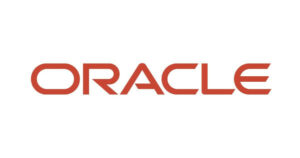The gig economy has boomed in recent years, and it shows no signs of slowing down. In 2024 alone, an estimated 41 million US workers reported having side hustles. While some Americans engage in a side gig because they’re passionate about it, the majority (72%) do it to supplement their regular income, according to a TurboTax survey of 1,000 side hustlers. And just under half (44%) have a side gig for the flexibility it provides.
In addition to running a survey about side hustles, we wanted to find out where various side hustles have the highest demand across the US. We also explore why particular side gigs thrive in these areas. You can see the full methodology at the end of the piece.
Where gig work is booming: The US cities with the highest side hustle demand
To identify where demand for hiring side hustlers is the highest, we analyzed search interest related to popular gig roles. This data highlights cities that have the strongest consumer demand based on where people are most actively searching for services:
- Freelance graphic design: Myrtle Beach, SC
- Dog walking: Boston, MA
- Pet sitting: Bend, OR
- Online Tutoring: Huntsville, AL
- Rideshare and delivery services: Honolulu, HI
- Virtual assistance: Santa Barbara, CA
- Handyman services: Youngstown, OH
- Social media management: Champaign, IL
- Photography: Elmira, NY, Rapid City, SD, Charlottesville, VA (tie)
- House sitting: Madison, WI
- Child care: Elmira, NY
- Personal assistance: Helena, MT
- Personal fitness training: Panama City, FL
- Lawn care and landscaping: St. Joseph, MO
- Vacation rentals: Panama City, FL
- House cleaning: St. Joseph, MO
Side hustle demand by city
Why side hustles are thriving in these cities
The demand for side hustles varies widely by location, driven by economic trends, lifestyle factors, and local demographics. Here are some insights that may explain why we see high demand for various side hustles in these cities:
- In tourism-driven cities like Honolulu, Myrtle Beach, and Panama City Beach, side hustles such as vacation rentals and rideshare driving may be in demand due to an influx of annual visitors.
- High-income areas like Santa Barbara and Boston drive demand for virtual assistants and house cleaning services, as residents with busy schedules and disposable income may often outsource tasks.
- College towns and business hubs, including Champaign, Huntsville, and Madison, create strong markets for tutoring, house sitting, and social media management—possibly driven by student populations and entrepreneurial communities.
Ultimately, side hustles thrive in cities where local needs align with flexible, service-based opportunities. These gig roles are filling gaps in local economies, providing steady income for independent workers.
Market competitiveness also plays a role in side hustle trends—63% of survey respondents with physical location-based hustles reported facing high competition. Those who work remotely may be able to avoid some of this competition, even if they live in more populous cities.
Realities of the side hustle economy: Trends in 2025
For many Americans, a side hustle isn’t just extra income—it’s a financial necessity. While the median US household income is $80,610, our survey found that 69% of side hustlers earn less than that, with 44% reporting household incomes under $50,000.
Why people choose to have a side hustles
Side hustles are often seen as a way to bridge financial gaps, but for many, the motivation extends beyond just making extra money.
- 72% of side hustlers started their gig to supplement their income, using it as a financial buffer for expenses, savings, or discretionary spending.
- 44% chose side hustling for flexibility, allowing them to set their own hours and work around their lifestyle.
- 10% hope to eventually quit their day job and transition their side hustle into a full-time business.
Beyond financial reasons, passion and personal interests also play a role in choosing the type of side hustle they want to work in:
- 44% of respondents pursued a side hustle based on a personal hobby or passion they wanted to monetize.
- 25% got their side hustle idea from social media, influenced by online trends and recommendations.
- 30% leveraged their existing job-related skills, making it easier to enter a familiar industry and start earning faster.
Finances and earnings
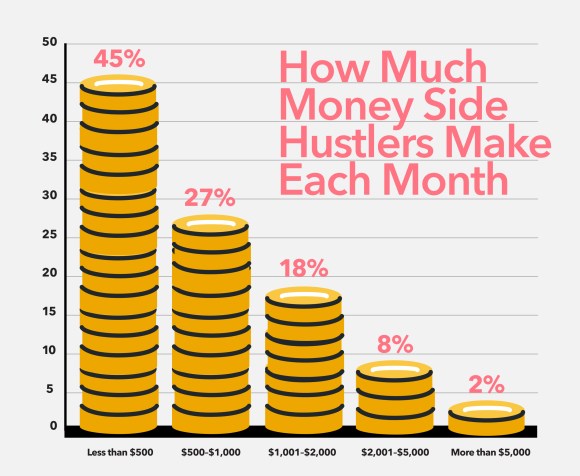
Although many people start a side hustle to make extra money, 45% earn less than $500 per month, while 27% bring in at least $1,000. The majority—79%—say their side hustle income is supplemental, while 21% rely on it as their primary source of income.
Side hustle income helps cover a variety of financial needs:
- 56% use earnings for regular bills
- 52% put it toward discretionary spending (vacations, shopping, entertainment)
- 40% save or invest their side hustle income
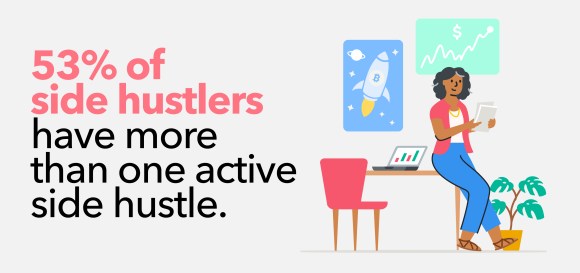
Interestingly, 53% of respondents manage more than one active side hustle, balancing multiple gigs to maximize earnings.
Popular side hustles
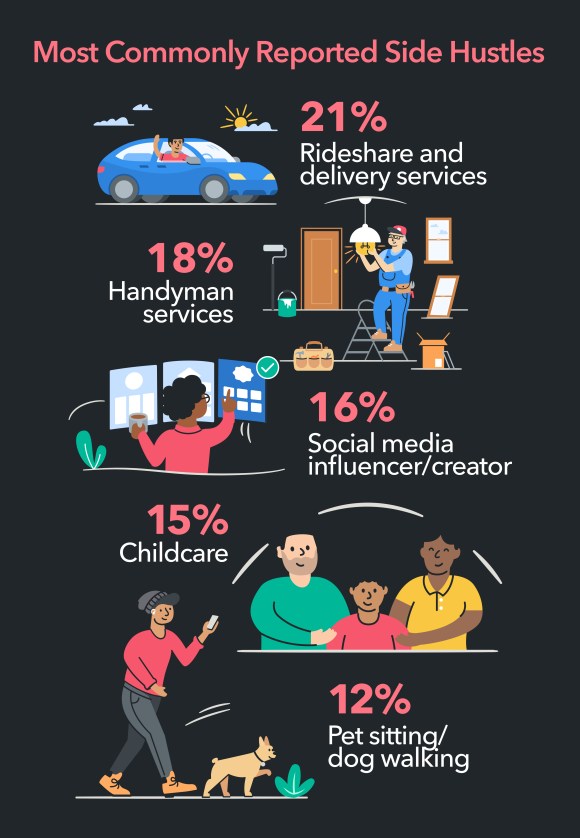
Some of the most commonly reported side hustles include:
- Rideshare and delivery services (21%)
- Handyman services (18%)
- Social media influencer/creator (16%)
- Babysitting and childcare (15%)
- Pet sitting and dog walking (12%)
Time commitments
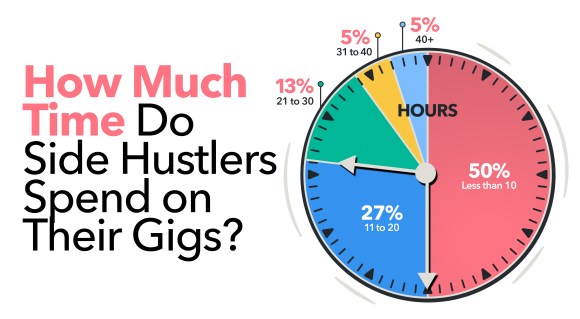
The time commitment varies:
- 50% of side hustlers work less than 10 hours per week
- 27% put in 11-20 hours
- 13% work 21-30 hours
- 5% spend 31-40 hours
- 5% dedicate 40+ hours
Flexibility is a major driver, with 44% of respondents saying they started their side hustle for the freedom it provides. However, only 10% have plans to quit their day job to pursue it full-time.
How side hustlers find work and manage their business
To attract clients:
- 49% use social media for promotion
- 46% tap their personal networks
- 31% leverage online platforms like Upwork or Fiverr
Managing finances and payments is also key, with 66% of respondents using digital payment and income management platforms like PayPal, Venmo, or QuickBooks.
The challenges of side hustling
Balancing a side hustle with daily life isn’t always easy. The biggest challenges reported by side hustlers include:
- Time management: 48%
- Finding clients: 35%
- Market competition: 30%
Additionally, 57% of respondents experience seasonal demand fluctuations, impacting their ability to generate consistent income.
A growing demand for side hustles
Despite these challenges, many side hustlers are seeing positive trends. In the past year:
- 37% reported an increase in demand for their services
- 34% gained new types of clients or customers
As financial concerns continue to grow, the gig economy is evolving, and side hustlers are adapting to meet changing market demands.
How to leverage these insights for your side hustle
Knowing the recent (and regional) side hustle statistics is one thing, but if you’re looking to boost your regular income, you need to take action. Here are some ways to leverage these findings to your advantage:
- Focus on cities where demand is high. Certain regions have higher demand for side gigs than others. Run an online search for terms like “side hustle in demand near me” or “top 10 side hustles in my area” to see what’s likely to generate income.
- Consider an online side hustle. You don’t necessarily have to live where you work. Our survey found that 26% of people are primarily based in a physical location, while 27% have a mixture of online and physical locations. If you’re struggling to find clients, consider working online.
- Expand your network and online presence. About half of respondents (49%) promote their side hustles (or find customers) on social media platforms like LinkedIn. Another 46% tap into their personal network. Choose a platform and stay active on it to build your online presence and attract more clients.
- Be aware of factors that impact your services. Some of the most popular side hustles are seasonal, so consider this when planning your services. If demand dips during certain times of the year, consider picking up another side gig until it picks back up.
- Use your existing skill set. Approximately 30% of people choose a side hustle for which they already have similar job-related skills or experience. While it doesn’t hurt to try something new, leveraging what you already know can make it easier to earn more.
- Keep innovating. If demand or income is lacking, it may be time to make a few changes. Evaluate the way you’re finding clients, how much you’re charging, and the services you’re providing to see where you can innovate or improve.
The Future of Side Hustle Demand in the US
The side gig industry isn’t going anywhere, but regional, lifestyle, and economic factors can all impact your earnings potential. Getting a feel for side hustle trends and demand can help you be strategic about where to offer your services and how to boost your income.
Of course, managing income from your side hustle can get complicated, especially during tax season. Whether you have one side hustle or several, TurboTax helps you easily navigate your taxes and get the deductions you deserve. You can either do your taxes yourself, or have one of our tax experts to file for you. File confidently and maximize your side hustle earnings with TurboTax.
Methodology
To identify the metropolitan areas with the highest demand for various side hustles, we used a multi-step process combining data from SEO tools, search demand tools, and secondary research.
- Side hustle selection: We analyzed popular and high-demand side hustles across the US, focusing on activities that provide flexible earning opportunities. To compile the list, we reviewed multiple sources, including industry reports, reputable publications, and popular freelance platforms.
- Keyword research and search intent: Using an SEO keyword research tool, we identified hiring or transactional queries that potential clients commonly use when seeking side hustlers.
- Search demand analysis: Each query was input into a search demand tool to assess search interest over a 12-month period and across metropolitan areas. Data was gathered on February 10, 2025. This helped determine which metropolitan areas showed the highest levels of interest for each side hustle category.
- Survey data integration: To support our findings, we integrated insights from a survey of 1,000 people with at least one active side hustle. This survey was conducted on December 9, 2024. These insights helped ensure our analysis reflected not just search behavior but the experiences of side hustlers across the US.





